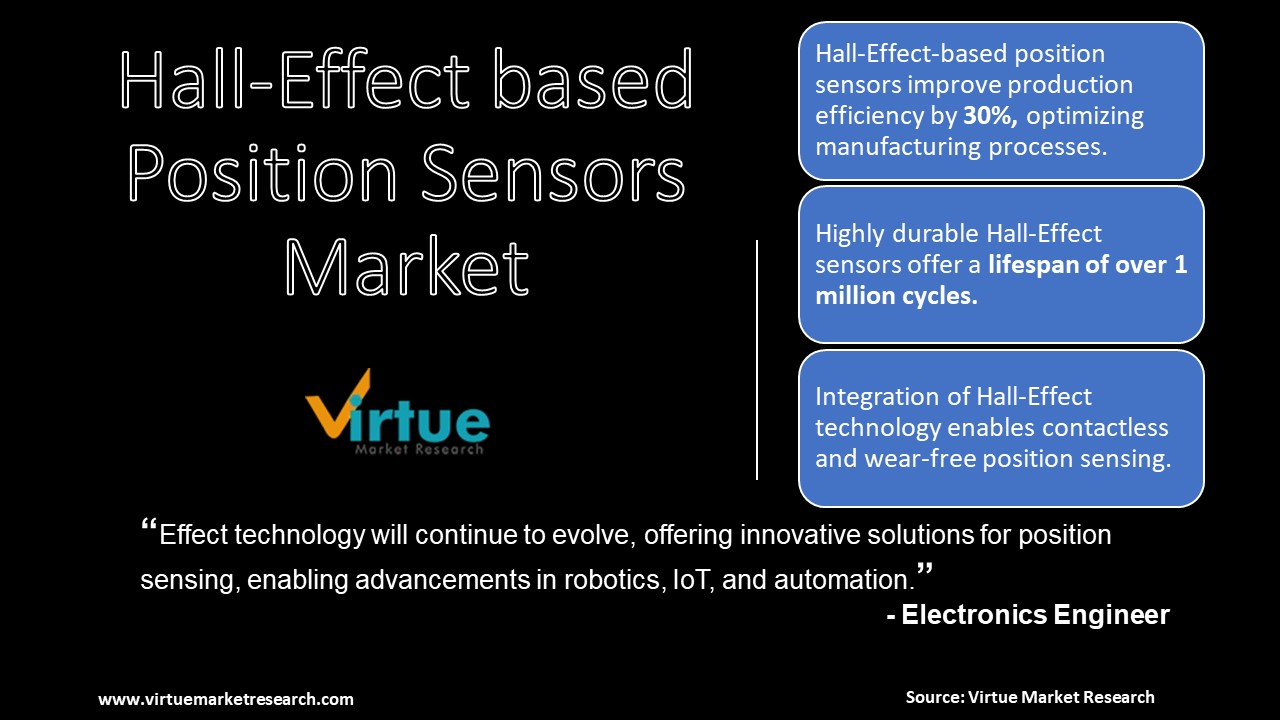HALL EFFECT BASED POSITION SENSORS MARKET (2023 - 2030)
The global Hall-Effect based Position Sensors Market size is estimated to grow from USD 1.3 Billion in 2023 to USD 1.97 Billion by 2028. The market is witnessing a healthy CAGR of 8.7% from 2023 to 2028. The rising use of Hall-Effect based Position Sensors in various industries is the major factor driving the industry's growth.
Industry Overview:
Hall impact sensors use ‘The Hall Effect principle to convert magnetically encoded information into electrical signals. The precept of Hall impact sensors relies upon electron mobility. These units have a range of applications, with Hall impact sensors frequently used in automotive structures to experience position, distance, and speed. They are typically used in automobile control structures like proximity sensing, face detection, anti-lock braking structures, and others, electronics, and size devices. The elements such as the rise in industrial automation, developing application of corridor impact sensors in robotics, growing used of programmable and utterly built-in modern-day sensors and transducers, and vast temperature steadiness in extreme environments in a broad range of enterprise verticals are assisting in the boom of this market.
The automobile market is moving to electrically pushed systems from mechanical actuation and timing methods. The world market for eco-friendly and hybrid vehicles is pushed by means of growing demand for gas, a rise in prices, and environmental concerns. Hall effect cutting-edge sensors locate their uses for a number of purposes such as converters, inverters, and battery administration units of HEVs and EVs. Hence, owing to the increase in Hall-Effect based Position Sensors Market, the world Hall-Effect Sensor Market will see a favorable boost. These factors are estimated to drive the market's growth during the forecast period 2023-2028.
COVID-19 impact on the Hall-Effect based Position Sensors Market
COVID-19 is an infectious ailment caused by the novel coronavirus. Largely unknown before the outbreak started out in Wuhan (China) in December 2019, COVID-19 modified into an international pandemic in no time. The COVID-19 pandemic has expanded the burden on healthcare structures throughout the globe. Companies scaled up R&D efforts to advance vaccines and drugs in opposition to the virus.
The outbreak of the novel COVID-19 pandemic is predicted to have a reasonable impact on the Hall-Effect based Position Sensors market in 2022. The demand from the industrial area witnessed a huge decline in particular in the first two quarters of 2022 due to stringent lockdown measures imposed with the aid of governments, restrictions on cross-border trade of non-essential commodities, and shutdown of the industrial area in a number of regions of the world. In addition, the disruption in the raw material supply chains generally due to the industrial lockdown throughout China is an important factor that led to a substantial decline in the standard manufacturing of hall-effect current sensors worldwide. However, the market is displaying symptoms of restoration in the remaining quarter of 2022, as the industrial quarter around the world continues to tread the direction of recovery.
MARKET DRIVERS:
The rising use of Hall-Effect based Position Sensors in various industries is driving the growth of the market
The Hall-Effect based Position Sensors Market is developing due to the rise in demand for sensors with greater accuracy levels, large working temperature levels, and correct results. The growing use of smart grids and rising security concerns inside industrial functions power the demand for corridor effect sensors. The rise in the implementation of enterprise four technologies such as industrial internet of things (IIoT) and cloud computing has created excessive demand for a range of sensors. Another indispensable part, DC motors, and switch control additionally use Hall Effect sensors for automation which are increasingly used in various industries. Hall impact sensors are also an effective, contactless way to measure DC magnetic flux in current transformers.

MARKET RESTRAINTS:
The lack of awareness is restraining the growth of the market
Hall-Effect based Position Sensors produce an output voltage at once proportional to the electricity of the magnetic area generated by the current supplied. It is related to an analog-to-digital (A/D) converter, microprocessor, or microcontroller to hold the voltage. Hall-Effect based Position Sensors work on the idea of the magnetic field, which makes them greater vulnerable to exterior magnetic fields, mainly to the inconsistent size of the current flow. These sensors are now not appropriate for measuring the glide of cutting-edge if the distance between the generated magnetic subject and the current-carrying conductor is passed certain limits which are predicted to restrict the market growth.
This research report on the global Hall-Effect based Position Sensors Market has been segmented and sub-segmented based on By Type of Loop, By End-User, and regions.
Global Hall-Effect based Position Sensors Market - By Type of Loop:
- Open Loop Sensor
- Closed Loop
Based on the Type of Loop, the open-loop phase is estimated to develop at a quicker rate with a CAGR of 9.8%, over the forecast length of 2023-2028. This is owing to the developing application of open loop corridor impact sensors in industrial equipment, ease of implementation of the mechanism, and galvanic isolation effect. Open loop cutting-edge sensors consist of a Hall sensor mounted in the air hole of a magnetic core. An open-loop Hall-effect sensor uses the Hall voltage immediately to produce its output sign making it simpler to enforce and revealing a faster response time. These sensors assist enhance the common effectivity and productiveness of an automation method due to the galvanic isolation effect. It is a primary aspect in the choice of an open-loop corridor impact sensor generally for contemporary dimension applications. Thus, open loop corridor sensors have countless advantages in industrial functions which are typically promoting the increase of this open loop corridor sensor segment.
Global Hall-Effect based Position Sensors Market - By End-User:
- Industrial Equipments
- Power & Energy
- Oil, gas, and petrochemical
- Automotive
- Consumer Electronics
- Telecommunication
- Healthcare
- Aerospace & Defense
- Manufacturing
- Robotics
- Others
Based on End-User, the industrial equipment phase held the biggest share of 32%, in 2022. This is owing to the growing want for precision manufacturing line tactics and extensive working temperature range in excessive industrial environments. Current sensors, strain sensors, and price of flow sensors are some of the considerably used functions of Hall-Effect based Position Sensors in industrial and manufacturing. In Industrial equipment, Hall-Effect based Position Sensors are used in protection systems, alignment controls, micrometers, laptop tools, key switches, linear potentiometers, rotary encoders, and brushless DC motor commutators. Thus, a large scale of equipment and technique line requirement of Hall-Effect based Position Sensors for industrial purposes is supporting the industrial equipment phase growth.
Global Hall-Effect based Position Sensors Market - By Region:
- North America
- Europe
- Asia-Pacific
- Latin America
- The Middle East
- Africa
Geographically, Asia Pacific (APAC) held the greatest Hall-Effect based Position Sensors Market share with 35% of the whole market size. This is due to growing government policies helping industrial automation and developing research in new technological integration in Hall impact sensors such as 3D sensing or bipolar complementary metal-oxide-semiconductor (BiCMOS) technology in nations such as China, India, South Korea, and Japan.
The current developments of graphene-based Hall-Effect based Position Sensors and programmable hall impact sensors are additionally boosting the boom in Asian countries. In June 2020, Melexis introduced an automobile-grade monolithic sensor that makes use of the Hall Effect to grant contactless sensing in the 3-d environment.
Global Hall-Effect based Position Sensors Market Share by Company
Companies like Infineon Technologies AG, ABB Ltd, Asahi Kasei Microdevices Corporation, Honeywell International Inc., LEM Holding SA, Kohshin Electric Corporation, Melexis NV, Allegro MicroSystems, LLC., STMicroelectronics N.V., TDK Corporation, Pulse Electronics Corporation. and others are playing an important role in the market. Mergers and acquisitions in the enterprise have enabled players to diversify and decorate their carrier services.
Recently, Texas Instruments launched the industry’s first zero-drift Hall-effect current sensors. The TMCS1100 and TMCS1101 allow the lowest drift and highest accuracy over time and temperature which is especially important for AC or DC high-voltage systems such as industrial motor drives, solar inverters, energy-storage equipment, and power.
The market is filled with many competitors which are making continuous efforts in the products to increase their revenue in the upcoming time. They are engaged in many activities such as collaboration and promotions which are estimated to drive the growth of the market during the forecast period. Companies involved in food testing and checking are now coming up with mergers and acquisitions with many other small and big enterprises in the same market to further extend their market share in recent times which is also estimated to drive the growth of the market.
NOTABLE HAPPENINGS IN THE GLOBAL HALL-EFFECT-BASED POSITION SENSOR MARKET IN THE RECENT PAST:
Product Launch- In Aug 2022, Texas Instruments launched TMAG5170, the first device in a new family of 3D Hall-effect position sensors for real-time control in factory automation and motor-drive applications.
Chapter 1. HALL EFFECT BASED POSITION SENSORS MARKET – Scope & Methodology
1.1. Market Segmentation
1.2. Assumptions
1.3. Research Methodology
1.4. Primary Sources
1.5. Secondary Sources
Chapter 2. HALL EFFECT BASED POSITION SENSORS MARKET – Executive Summary
2.1. Market Size & Forecast – (2022 – 2026) ($M/$Bn)
2.2. Key Trends & Insights
2.3. COVID-16 Impact Analysis
2.3.1. Impact during 2022 - 2026
2.3.2. Impact on Supply – Demand
Chapter 3. HALL EFFECT BASED POSITION SENSORS MARKET – Competition Scenario
3.1. Market Share Analysis
3.2. Product Benchmarking
3.3. Competitive Strategy & Development Scenario
3.4. Competitive Pricing Analysis
3.5. Supplier - Distributor Analysis
Chapter 4. HALL EFFECT BASED POSITION SENSORS MARKET - Entry Scenario
4.1. Case Studies – Start-up/Thriving Companies
4.2. Regulatory Scenario - By Region
4.3 Customer Analysis
4.4. Porter's Five Force Model
4.4.1. Bargaining Power of Suppliers
4.4.2. Bargaining Powers of Customers
4.4.3. Threat of New Entrants
4.4.4. Rivalry among Existing Players
4.4.5. Threat of Substitutes
Chapter 5. HALL EFFECT BASED POSITION SENSORS MARKET - Landscape
5.1. Value Chain Analysis – Key Stakeholders Impact Analysis
5.2. Market Drivers
5.3. Market Restraints/Challenges
5.4. Market Opportunities
Chapter 6. HALL EFFECT BASED POSITION SENSORS MARKET – By Type Of Loop
6.1. Open Loop Sensor
6.2. Closed Loop
Chapter 7. HALL EFFECT BASED POSITION SENSORS MARKET – By End - User
7.1. Industrial Equipments
7.2. Power & Energy
7.3. Oil, Gas and Petrochemical
7.4. Automotive
7.5. Consmer Electronics
7.6. Telecommunication
7.7. Healthacare
7.8. Aerospace and Defence
7.9. Manufacturing
7.10. Robotics
7.11. Others
Chapter 8. HALL EFFECT BASED POSITION SENSORS MARKET - By Region
8.1. North America
8.2. Europe
8.3. Asia-Pacific
8.4. Latin America
8.5. The Middle East
8.6. Africa
Chapter 9. HALL EFFECT BASED POSITION SENSORS MARKET – By Companies
9.1. Infineon Technologies AG
9.2. ABB Ltd
9.3. Asahi Kasei Microdevices Corporation
9.4. Honeywell International Inc.
9.5. LEM Holding SA
9.6. Kohshin Electric Corporation
9.7. Melexis NV
9.8. Allegro MicroSystems, LLC.
9.9. STMicroelectronics N.V.
9.10. TDK Corporation
9.11. Pulse Electronics Corporation
Download Sample
Choose License Type
2500
4250
5250
6900
Frequently Asked Questions
The Global Hall-Effect based Position Sensors Market was estimated at USD 1.3 Billion in 2023 and is anticipated to be a value of USD 1.97 Billion by 2028, growing at a fast CAGR of 8.7 % during the forecast period 2023-2028.
The Global Hall-Effect based Position Sensors Market drivers are rising demand in various industries such as automobile and power generation.
The Segments under the Global Hall-Effect based Position Sensors Market by End-User are Industrial Equipment, Power & Energy, Oil, gas and petrochemical, Automotive, Consumer Electronics, Telecommunication, Healthcare, Aerospace & Defense, Manufacturing, Robotics, Others
China is the most dominating country in the Asia-Pacific region for the Global Hall-Effect based Position Sensors Market.
STMicroelectronics N.V., TDK Corporation, and Pulse Electronics Corporation are the leading players in the Global Hall-Effect based Position Sensors Market.



